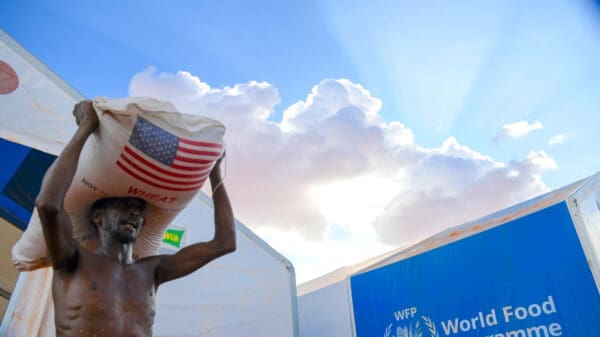The Future of International Relief: Co-Creation With the Private Sector

Reposted with permission of The NonProfit Times
International humanitarian organizations have faced a surging demand for their services for the past several years. Even before COVID-19 arrived and made the work harder and more urgent, other, more powerful headwinds were already stalling or even reversing our forward progress. The international relief community is facing numerous, concurrent humanitarian crises.
Countries experiencing protracted humanitarian crisis have more than doubled over the last 15 years. Five years ago, 80 million people were on the brink of starvation and relied on lifesaving food assistance daily to survive. In 2019, that number was 149 million, and the blunt force of the COVID-19 pandemic has driven that number this year to a staggering 270 million people.
Likewise, the United Nations High Commissioner for Refugees, the world’s leading refugee agency, has during the past several years documented (and responded to) an alarming rise in the number of displaced people in the world. By the end of 2019 — before COVID-19 descended on most of the world — that number was 79.5 million people, or more than 1% of all humanity, and more than the agency has ever recorded.

Refugees queue for WFP food distributions in Um Rakuba refugee camp in eastern Sudan.
Why is this happening?
The answer is, of course, complicated. But there is no doubt that the emergence of climate change, the proliferation of conflict and the stubborn presence of extreme poverty are among the most prominent drivers of the alarming changes we are seeing in the international humanitarian sector.
Try as we do to provide for every person in need, these much bigger forces are overtaking our capacity to implement lasting lifesaving and life changing programs. To combat these forces and be relevant into the future, we need to think and act boldly.
As we move into the next decade, we need to re-imagine how we do our jobs, particularly in light of the coronavirus pandemic. This means analyzing the critical problems that are arising and asking ourselves: What technologies and wholly new approaches could we develop in the future to solve them? We need to brainstorm and test new ideas and also present our challenges to the technology and innovation community to help us with the big solutions.
Donor government support, which has helped to sustain the humanitarian sector for decades, will always be essential to that mission. But private sector businesses and philanthropy can give us an even greater edge not just to carry out our most immediate work, but to help us co-create the ideas and approaches that will blunt the impact of these drivers.
It is fortunate that, as a sector, we benefit from much-needed cash and in-kind assistance from the private sector. But we have only scratched surface of what is possible.
Humanitarian groups can benefit greatly from a model of co-creation, which taps the deep well of innovation and research and development that exists in many major businesses and that we, quite frankly, don’t typically have the resources or the experience to do well.
A number of innovative companies already go to great lengths to join us in such co-creation. UPS, for example, provides the U.N. World Food Programme funding and their employees’ expertise to improve our elaborate and far-reaching supply chains.

WFP works on the logistics, transport and storage of relief supplies worldwide.
But there is ample room — and, I would add, a moral imperative — for many more companies to follow that example, especially those in industries such as financial services (e-cards), data analytics (blockchain technology), logistics and transportation (self-driving and no-emission vehicles), to name a few.
Companies can surely benefit from such co-creation partnerships with introductions to new markets and business opportunities. But, as long as companies come to these partnerships with a spirit of public service and not purely for commercial gain, their help can be transformative.
Recruiting companies into this work is only part of the challenge. Our sector needs to do more to establish an internal structure and culture that welcomes and nurtures innovation. We have to let go of long-held, and often out-of-date, preconceptions that the for-profit and the non-profit worlds are spinning in different and incompatible orbits. We must, instead, embrace the benefits that can come from working together.
Co-creation is what we strive for
The U.N. World Food Programme, through its Innovation Accelerator, incubates and nurtures new, potentially scalable ventures to sharpen our impact. Our Innovation Accelerator has sought to leverage new digital analytical tools that make our work more efficient, spur agricultural research and approaches that can help countries grow more of the food they need and apply blockchain technologies to secure and speed cash transfers to refugees to purchase food more easily. We are also working on new innovative finance mechanisms, such as crowdfunding, social impact bonds and disaster insurance, programs that seek to draw from a deep pool of available private capital to solve urgent humanitarian needs.
Beyond private sector companies, there is a great deal more that international relief organizations can gain from the philanthropic community. I have worked in development for more than two decades – much of it in the international humanitarian sector – and helped raise substantial sums from some of the most generous people on the planet. But the more I work with philanthropists and high-net worth people and families, the more I realize how much more potential support remains on the sidelines.
Two years ago, the Bridgespan Group spelled this out more specifically when it reported that “ultra-wealthy American families donated just 1.2% of their assets to charity in 2017, which falls considerably short of average, long-term investment returns on assets.” The Bridgespan report also asserts that the lion’s share – approximately 80% — of that philanthropy in the U.S. goes to large institutions (such as hospital systems, university and big cultural organizations) and that social-change organizations receive much less.
But the real value of philanthropy, at least when it comes to humanitarian relief, goes far beyond the dollars they provide. Indeed, private philanthropies make up only about 1% of total funding for the humanitarian sector. Still their involvement with our sector can make a huge difference. As a report this year from the Conrad N. Hilton Foundation notes, philanthropies can deploy their funding quickly and flexibly and into higher-risk, long-term initiatives, and their prestige, convening power, as well as expertise in certain innovative areas can drive broader systemic changes that can help humanitarian groups to more and do it better.
Particularly since COVID-19 has unfolded, governments have come to understand that global challenges require global responses and that we are all less well off when others around the world are hurting. That is a message I hope more of our co-creators – and would-be co-creators – in the private sector take to heart and act on. The need is too great to ignore and the consequences are clear … people will die.
* * *
Barron Segar is president and chief executive officer of World Food Program USA in Washington, D.C.




